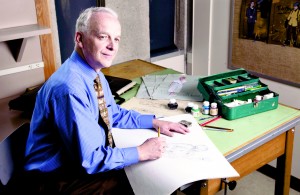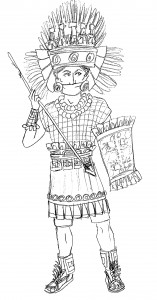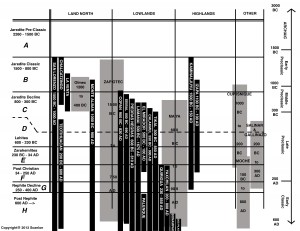
BYU professor Rory Scanlon’s creativity when designing ancient Bible and Book of Mormon attire is not a product of chance.
Scanlon and his team of student researchers in BYU’s department of theatre and media arts have spent more than a decade investigating the pre-Columbian Mesoamerican era with the purpose of discovering how the people in the Book of Mormon might have dressed.
“Our research is unique in the sense that most ancient Mesoamerican history authors are not LDS,” Scanlon said. “And these writers are not going to be talking about Book of Mormon people or places. This is why having an LDS perspective allows us to see how certain cultures and events can only fit in so beautifully with our ancient text.”
Scanlon’s research faces its own unique set of challenges. Historicity and specificity are his areas of interest.
“Mormon did an incredible job at abridging for us,” Scanlon said. “You can tell that there was so much more going on at the time, but he knew that what he needed to focus on was the spiritual aspect, the true faith and the beliefs of the people. That is why three-fourths of the Book of Mormon is the Law of Moses, a law that told them not to make images. So they didn’t collect; they didn’t paint on walls. They didn’t write their history visually. They didn’t sit there and say, ‘Today, I am wearing such and such.'”

Scanlon attributes the lack of clothing descriptions in the Book of Mormon to the need for focusing on timeless doctrine instead of everyday details.
“It would be like you writing your journal in perspective of your family. Think about it for a second. You are not going to write mundane details of your neighbors wearing jeans and plaid shirts,” Scanlon said. “But you are going to say ‘The neighbors attacked us, and they were only wearing a loincloth.’ And you would not write that unless it was unusual, would you?”
According to Scanlon, a lot of Mesoamerican civilization still remains a mystery to modern society. He attributes this to the various regimes that built on top of each other in order to make their people forget about their previous leaders.
“It is really hard to judge factual history if you’ve got to go from the records that people kept at the time,” Scanlon said. “It is very likely that when the next leading regime took over, they wiped out the history of the last one. So, your history is only going to wind up being the history of the last people that were there. Which makes our research not only difficult but almost intangible.”
Nevertheless, when historical details are not an issue, the other challenge researchers face is creating fabrics that match the look and feel of antique clothing. This is why they employ custom specialty cloths.
“We have a weaving guild in Logan that raises the same kind of sheep that they had in the Old World, and some of these materials serve as the foundation of our clothing,” Scanlon said. “This is how we are able to capture the unique texture and feel of antique clothes.”
Scanlon and his creative team have worked on various requests from The Church of Jesus Christ of Latter-day Saints. One of their biggest projects was to research and design Old World costumes for the LDS visitors’ center in Salt Lake City.

“If you go to the Salt Lake visitors’ center downstairs, they have the hall of the prophets. My students and I created those costumes,” Scanlon said. “And two of those costumes had to be handwoven, since you can’t find the fabrics that fully capture the simple and yet complex feeling of the Old World.”
Scanlon also served as the main innovator to many changes to costumes for the Hill Cumorah Pageant in New York from 2001 to 2007.
Lydia Cooper has visited the Hill Cumorah Pageant with her parents since 1996. She mentioned seeing the wardrobe changes in recent years and feels that the current wardrobe “nails it.”
“I have been to the Hill Cumorah pageant before they made the wardrobe changes,” Cooper said. “Initially, you could tell their efforts were focused on the acting, while the costumes resembled stuff that you could buy at JC Penney. I revisited the pageant back in 2003, and wow, what a change. I said to myself, ‘This is what Moroni looked like.’ Because I, for one, didn’t believe that Captain Moroni’s armor resembled a Roman soldier, so his costumes (Scanlon’s) give me a solid idea of what Book of Mormon people truly looked like. He nailed it.”
BYU professor of ancient scripture Ray Huntington said Scanlon’s research is valuable, as it helps people appreciate the significance of doctrinal context.
“While knowing what people dressed like, how they acted, what their day-to-day lives were like doesn’t impact the doctrine, it is still meaningful,” Huntington said. “What this research does for me as a member of the church is, it makes the context in which the doctrine was given not only more factual and more alive, but also more meaningful.”
Ultimately, Scanlon feels that while his research focuses on the external appearance of an entire civilization, knowing more about ancient Book of Mormon clothing can only help members of the church to better understand their religion.
“Studying Mesoamerican clothing can help us unlock other layers of understanding that we have to get through to really understand the Book of Mormon,” Scanlon said. “We have to get into the historicity, visit their possible locations and dig deeper in order to really understand this very real civilization.”




